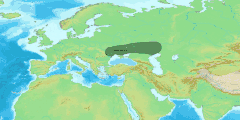Multi-cordoned ware culture
Multi-cordoned Ware culture or Multiroller ceramics culture, translations of the Russian: Культура многоваликовой керамики Kul'tura mnogovalikovoj keramiki (KMK),[1] also known as the Multiple-relief-band ware culture, the Babyno culture and the Mnogovalikovaya kul'tura (MVK), are archaeological names for a Middle Bronze Age culture of Eastern Europe.
| Part of a series on |
| Indo-European topics |
|---|
 |
|
|
Philology
|
|
Origins |
|
Archaeology Pontic Steppe
Caucasus East Asia Eastern Europe Northern Europe Pontic Steppe Northern/Eastern Steppe Europe
South Asia Steppe Europe Caucasus India |
|
Peoples and societies Indo-Aryans Iranians
East Asia Europe East Asia Europe
Indo-Aryan Iranian
|
|
Religion and mythology
Indo-Aryan Iranian Others Europe
|
|
Distribution
From approximately the 22nd to 18th centuries BCE, it occupied an area stretching from the Don to Moldavia, including Dnieper Ukraine, Right-bank Ukraine, and part of the modern Ternopil Oblast, and was bordered by the Volga to the east.
Origins
KMK succeeded the western Catacomb culture.
Characteristics
In 1929, the archaeologist Ya. Brik studied four kurgans of this culture near Ostapye village, Podvolochisk raion, Ukraine. He found ceramics, flint tools, bone and bronze decorations. Bottoms, walls and ceilings of the graves are layered with rocks. Skeletons are laid in contracted position towards the east.
The name of this culture is related to its ceramic goods, such as pots, which were decorated with multiple strips of clay (cordons) before firing. The culture also featured various other distinctive ornaments
KMK tribes practiced herding and made widespread use of chariots.
Physical type
The physical type of the Multi-cordoned Ware culture has been designated as dolichocephalic.[lower-alpha 1]
Ethnicity
Circumstantial evidence links KMK to the spread of one or more Indo-European languages. Leo Klejn identifies its bearers with the early Thracians. Other scholars suggest that KMK may have been connected to the Bryges and/or Phrygians.
Successors
It was increasingly influenced, assimilated and eventually displaced by the Timber grave or Srubna/Srubnaya culture.[3][4][5][6] In c. 2000 – 1800 BCE bearers of KMK migrated southward into the Balkans.
Notes
- "During the period of the Timber-grave culture the population of the Ukraine was represented by the medium type between the dolichocephalous narrow-faced population of the Multi-roller Ware culture..."[2]
References
- Kohl, P.L. (2007). The Making of Bronze Age Eurasia. Cambridge University Press. p. 146. ISBN 9781139461993. Retrieved 2014-10-09.
- Kuzmina 2007, p. 384.
- Валиковой керамики культура // БРЭ. Т.4. М.,2006.
- Киммерийский период // БРЭ. Т.13. М.,2008.
- Киммерийцы // БРЭ. Т.13. М.,2008.
- Евразийская степная металлургическая провинция // БРЭ. Т.9. М.,2007.
Sources
- Kuzmina, Elena E. (2007). Mallory, J. P. (ed.). The Origin of the Indo-Iranians. BRILL. ISBN 900416054X.CS1 maint: ref=harv (link)
Literature
- Куштан Д.П. Памятники Культуры Многоваликовой Керамики В Среднем Поднепровье (По Материалам Разведок В Зоне Кременчугского Водохранилища)
- Тернопільський енциклопедичний словник. — Тернопіль, видавничо-поліграфічний комбінат «Збруч», том 1, 2004.
- Тернопілля: сторінки історії. — X, 1995;
- Словник-довідник з археології. — К., 1996.
External links
- {{Country data {{{1}}}
| flaglink/core | variant = | size = | name = | altlink =national rugby union team | altvar =rugby union}} Подборка публикаций о КМК на сайте Archaeology.Ru